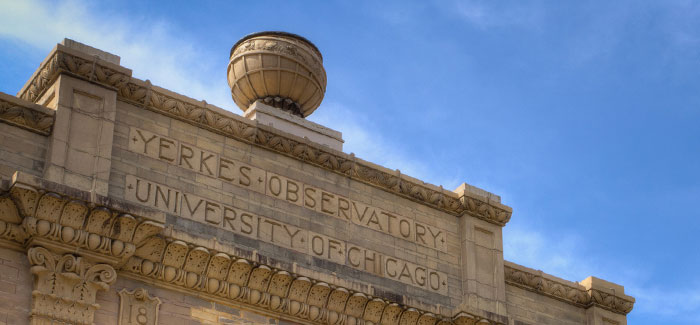There’s life in the old observatory yet.
In 2006 the University of Chicago
announced a plan to dispose of the beautiful, historic, but obsolete Yerkes Observatory in Williams Bay, Wisconsin. The plan was to sell it to a developer, who would turn the grounds into a resort along Geneva Lake and preserve the building itself as a museum and educational center. But the Village of Williams Bay refused to give the developer the zoning variance it needed, and the economic downturn of 2008 put the kibosh on any idea of developing the property. By default, the observatory remained property of the University, and its ultimate fate was in limbo.
Since then, “the University has done a 180” on its plans for the observatory, says Jim Gee, MBA’81, Yerkes’s business manager. Instead of preparing for its disposal, the administration and the Yerkes staff have tried to find a way to get more out of the observatory’s existing facilities and budget. (The most noticeable: the University is restoring the building’s terra cotta facade.) The “big astronomy” that the observatory was built for is probably gone for good, Gee says, but that doesn’t mean the facility can’t find a second life advancing science.
[[{"type":"media","view_mode":"media_original","fid":"640","attributes":{"alt":"","class":"media-image","height":"296","typeof":"foaf:Image","width":"460"}}]]
The HAWC with SOFIA model plane in foreground. (Photography by Benjamin Recchie, AB’03)
In the building’s basement is an engineering shop with what looks like an enormous copper coffee can, called
HAWC (
High-Resolution Airborne Wideband Camera). It’s an instrument under construction for
SOFIA (the Stratospheric Observatory for Infrared Astronomy), a Boeing 747 with a telescope mounted where the economy class seats used to be. Engineer Eric Sandberg is putting the final touches on
HAWC. When it’s ready to ship out to California to be mated to
SOFIA, the instrument will be cooled down to 0.2 kelvin—less than a degree above absolute zero—to be sensitive enough for the camera to work.
The bad news is the instrument is behind schedule; it’s taken them 12 years to get to this point. The good news is that infrared detector technology has advanced past the state of the art when
HAWC was designed, so Sandberg is upgrading the instrument. Instead of just being able to detect infrared radiation,
HAWC will be able to detect its polarization as well, which adds another layer of information that can be gleaned from observations. There are more upgrades already in the pipeline, although these are still years away. That’s the advantage of having an observatory that flies on an airplane rather than one shot into space, he says—you can repair and modify it every time it lands, instead of hoping you got it right the first time.
[[{"type":"media","view_mode":"media_original","fid":"642","attributes":{"alt":"","class":"media-image","height":"296","typeof":"foaf:Image","width":"460"}}]]
[[{"type":"media","view_mode":"media_original","fid":"641","attributes":{"alt":"","class":"media-image","height":"296","typeof":"foaf:Image","width":"460"}}]]
Three dimensional objects created in the Fab Lab, above. Bob Hirsch with the fabber, below. (Photography by Benjamin Recchie, AB’03)
In another workshop, engineer Bob Hirsch is unpacking a new 3-D printer. It “prints” layers of material—usually plastic—to slowly build up a three dimensional object; Hirsch used one to make prototype parts for
HAWC. The printer is a key to the Fab Lab, which will replace the
HAWC workshop once that instrument ships out and which will contain the printer, a laser cutter, and a robot router. The lab’s primary use will be educational, says Gee, teaching students basic engineering principles and how to use computer-aided design software, a kind of 21st century shop class. The lab was paid for by raising funds from the local community, with an eye toward preparing the children of southeast Wisconsin and northern Illinois for careers in science and engineering.
Once a month, Yerkes has been sponsoring star parties, where amateur astronomers (and not a few youngsters) come together to do a little stargazing as a group. I ask Vivian Hoette, the observatory’s educational outreach coordinator, what kind of turnout they get? Huge, she says: “People come from Chicago, from Madison, Racine, Waukesha, Whitewater!” Hoette runs a slew of outreach programs, including the star parties and supervising a score of local high school students who do research at the observatory. One project examines old photographic plates taken at the observatory to measure the brightness of long-period variable stars, whose luminosity changes over years or decades. Another team participates in asteroid-hunting, which I tried to do at Yerkes a year after graduating from the College.
Hoette also participates in the
Skynet Junior Scholars program, a collaboration between
Skynet (a worldwide network of robotically operated telescopes), multiple universities (including Chicago), and 4-H, funded by a $1.6 million grant from the National Science Foundation. It will allow middle schoolers (and their teachers) to “order” observations of celestial objects; Skynet puts the orders in a queue and provides them with a digital image when it’s completed. Hoette loves the fact that Skynet puts to work often underused telescopes, including two at Yerkes. “The light from those stars didn’t come all this way for nothing,” she laughs.
Skynet has long been available to high school students (and professional astronomers, who use it to follow up reports of short-lived gamma ray bursts), but there’s a reason they want to expand the program to a younger group: middle school is the age when many children develop an interest in science and engineering careers. Skynet Junior Scholars provides something exciting for the teachers to present to their students while making the kids part of a real scientific team.
Yerkes’s raison d’etre when it was built was its 40-inch refracting telescope, at the time the largest in the world. It instantly made Chicago a major institution for astrophysics, but it’s now little more than a well-preserved museum piece. But if the 40-inch represents Yerkes’s past, the Fab Lab and Skynet may represent the future.

